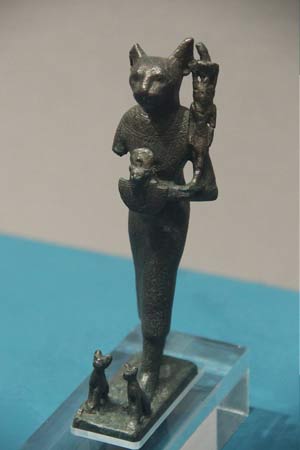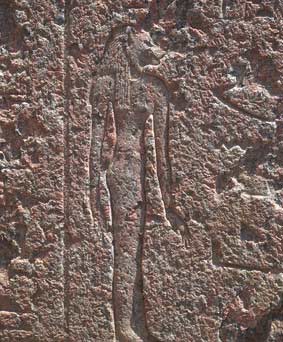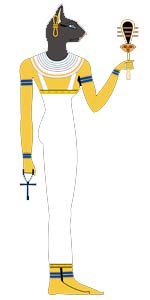The Egyptian Goddess Bastet
Bastet, also called Bast, was one of many Ancient Egyptian gods, associated with the lioness and later the cat. She was the goddess of protective ointments and potions, pleasure, and health. She was considered a protector deity of both humans and felines. She was also the gentler version of her sister goddess, Sekhmet.
Bastet's Origins
The figure of Bastet dates back to at least 2800 BC, during the Second Dynasty, where the Bastet hieroglyph and image adorn many burial items. Other early evidence of her worship are sites like Bubastis, from which her name may have originated, and Thebes. It is also possible that her name came from the Ancient Egyptian word for ointment jar.
As time passed, Bastet came to be more associate with the cat than the lioness, and people worshipped her through protective spells, inscriptions, and the mummification of cats. Her origins may also be traced to Egyptians who observed lionesses hunting around a seasonal lake called Wadi Tumilat. No matter her beginnings, Bastet was considered a daughter of Ra and was thus one of the primary deities of the Ancient Egyptian pantheon.
Iconography and Attributes

Image: © Garry Todd - Bronze statue of Bastet
In the earliest Bastet iconography, she is depicted with the body of a slender female and the head of a lioness. Her cat-headed form became her primary symbol during the later New Kingdom period, after 1100 BC. In many of these depictions, which include small statues and images on jars of ointment, she is purely a cat, sitting still and erect but acutely aware of her surroundings.
While her transformation from lioness to cat may seem incongruous, it fits with Ancient Egypt's regard for both. Cats were instrumental in hunting and killing disease-ridden mice in homes and crops. Accordingly, Bastet became a protector deity, guarding the hearth and families and eventually the pharaoh himself.
Typified by fierceness and violence but also loyalty, Bastet became a figure to be emulated among the pharaohs. According to the Loyalist Instructions, a text from the 12th Dynasty, "He is Bastet who protects the two lands. He who worships him will be protected by his arm. He is Sekhmet against he who transgresses his order. The one he hates will be under distress." In this teaching, Bastet and Sekhmet are conflated, showing her dual nature as fierce huntress and dedicated protector.
Bastet was also depicted as the Eye of Ra in later religious and literary texts. This came about through the interactions she had with the Eye and the god Seth.
Roles
As mentioned above, Bastet was the goddess of healing ointments. But she was also goddess of the home, domestic life, cats, women's untold secrets, fertility, and birth. She guarded families against evil spirts and diseases, especially those of women and their children. She was also depicted guiding the spirits of the dead to the afterlife.
She was the daughter of the sun god Ra, sister of Sekhmet, and sometime rival of Seth, from whom she rescued the all-seeing Eye of Ra on her father's behalf. This is why she is depicted in many religious texts as "the Eye of Ra" itself. But it is important to note that this title was not distinct to Bastet.
Sekhmet and the Hathor (a goddess of music, love, wine, and motherhood) also had these titles. There is significant overlap between their attributes and the mythical stories surrounding all three of them. A good deal of this overlap can be explained by the fact that many deities were associated with one or two regions or cities before they became more universal when the Upper and Lower Kingdoms of Egypt were united.
It is also important to note that this occurred because the Egyptian religion was continual evolving over roughly 3,000 years, making certain attributes and stories interchangeable, as will be seen when reading about different festivals.
Worship and Festivals
The Festival of Bastet was celebrated initially in the cities of Bubastis, Esna, and Thebes. Bubastis, from which Bastet's name may be derived, was the chief location for this celebration involving wine, boating, and song. The chief temple dedicated to her was in that city. If the Greek historian Herodotus is to be believed, the women on boat would verbally abuse the residents of each passing town while lifting their skirts. Worshipping in this manner was referred to as "sacred drunkenness."
Like Sekhmet and Hathor, Bastet (as the Eye of Ra) was appeased through offerings of wine and sometimes red-colored beer (as a replacement for the blood of human beings). Bastet was also worshipped during the Egyptian New Year next to Hathor. During this time, small cat statues were exchanged between households, yet another symbol of Bastet's ubiquity.
Bibliography
- The Egyptian gods and goddesses : the mythology and beliefs of ancient Egypt

Image: Aidan McRae Thomson
Hiëroglyph of Bastet

